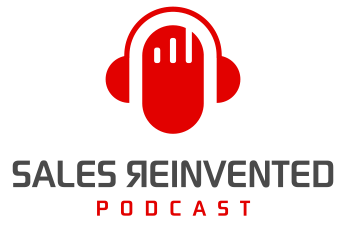Episode #399: Mark Sellers

Meet
Mark Sellers
Mark is founder and managing partner of Breakthrough Sales Performance, a sales training, coaching and consulting company he founded in 1998. Mark helps sales leaders drive accountability and results with sales processes, and helps salespeople achieve full potential in their careers by dealing with their sales Blindspots.
Mark created the BuyCycle Funnel™ sales model that sparked a revolution in sales by aligning selling activities to the customer’s buying journey. 140 sales teams in 19 countries have implemented the BuyCycle Funnel™ process.
Mark is the author of The Funnel Principle (called “revolutionary” by Selling Power magazine) and Blindspots: The Hidden Killer of Sales Coaching.
Our Mission Is To Change The Negative Perception Of Sales People
Our Vision Is A World Where Selling Is A Profession To Be Proud Of
Between people not answering calls from phone numbers they don’t recognize, to spam filters, to people silencing their phones—it’s become harder and harder to connect when making cold calls. What is a salesperson supposed to do?
Mark Sellers joins me in this episode of Sales Reinvented to share how he navigates making cold calls (or sending cold emails) in a way that captures his prospect’s interest—and respects their time.
Outline of This Episode
- [1:17] Is cold-calling still relevant?
- [3:04] Is cold-calling an art and science?
- [3:38] How Mark prepares for cold-calling
- [5:51] How to capture a prospect’s interest
- [7:58] Why Mark is a fan of using scripts
- [10:16] Tools and strategies to leverage
- [12:25] Mark’s top cold-calling dos and don’ts
- [15:52] The best way to handle objections
How Mark prepares for cold-calling
Mark approaches cold calling well-prepared. He checks out someone’s LinkedIn profile and their website. He has an exact reason ready for why he’s calling that person. They deserve to have a good reason for the call. It may not be enough to get them to book a call but it does show them respect. Mark books blocks of time to do calls or emails. He’s also mentally prepared for any kind of response that comes his way.
How to capture a prospect’s interest—and respect their time
Tell them who you are, what you want, and why you’re calling them immediately. Mark will say “If you have 60–90 seconds, I’ll tell you why I’m calling and why I’m asking for your time.” Years ago, he was hired to help a company build out their online sales course practice. His job was to recruit subject matter experts to join the group, create a course, and earn some money. That’s the line he used and every single person stayed on the line. Listen to learn what else he does!
Why Mark is a fan of scripts
Have you been to a great Broadway production? Someone has memorized a script and recites it word-for-word every single show. Yet it never feels like it, right? You have to be professional and rely on a script when it comes to cold calls—not just your experience and natural talents.
Mark thinks your call—especially if the sole purpose is to get a meeting—should be short. If you’re dialing a lot, the chances are better that you’re trying to sell on that call. But those calls still need to be long enough to get into their needs, product specifics, pricing, etc. The purpose dictates the length of the call.
The best way to handle objections
Mark’s strategy is to acknowledge the objection and then give it space. You don’t have to get defensive and list all of the reasons why they’re wrong. Customers don’t want to hear that. Instead, ask if they have any other objections. What don’t they like? What are you missing?
Focusing on the positives and the rest of what you plan to say can help turn things around. Mark usually ends a call with, “Would it be reasonable to take the next step?” Most people say yes because they’ve felt heard and understood.
Most salespeople need to do a better job of emotionally connecting with prospects. You do this by not being overly aggressive or assertive. When you surprise a customer by being different, it gets the kind of attention you want.
Listen to hear Mark’s top cold-calling dos and don’ts!
Connect With Paul Watts
Audio Production and Show notes by
PODCAST FAST TRACK
https://www.podcastfasttrack.com
Learn More from Mark Sellers
What was a pivotal moment or experience in your career that shaped your approach to cold calling, and how did it change your perspective or strategy? I started cold calling in my first job out of college. As a pharma rep I had maybe 30% booked appointments and the rest was dropping in unannounced. I learned a lot about rejection and persistence. To improve my chances of getting through I had to have something that somebody wanted. Sometimes that was product or samples and sometimes it was a smile and a friendly conversation.
Can you share a specific tactic or approach you’ve used in cold calling that significantly increased your success rate? Please provide a brief example or case study. As soon as they pick up I say my name, who I work for, what I do and why I’m calling. I think this has been so successful because it shows respect. It’s this phase of the interaction where we completely at the mercy of the prospect and they need to know that know that. Later in the interaction I try to shift that balance of power because my time is just as important as the prospect’s.
Cold calling often comes with its set of challenges and rejections. Can you share a particularly tough challenge you faced while cold calling and how you overcame it? The challenge for me is to come up with something I think the prospect would find intriguing or compelling enough to invite me in. I find myself often spending a lot of time thinking through this and I actually enjoy that part of my job.
What are the top three tools or resources (e.g., software, books, training programs) you consider essential for someone looking to improve their cold calling skills and outcomes? First get a good script. Second, practice it, maybe 20-25 times before you pick up the phone or send the email. Third, playbooks can be terrific guides to follow. A playbook might be a little more flexible than a script.
How do you foresee the practice of cold calling evolving in the next few years with advancements in technology and changes in buyer behavior? What advice would you give to sales professionals to stay ahead of the curve? Cold calling may be under attack from technology and may evanesce – caller id and unknown numbers going straight to voice mail – but maybe a new opportunity emerges that highlights the need for higher quality cold calling practices. That is, doing good research, knowing some things about this person you want to talk to and the business she works for, and the industry both are in. And having a darn good reason to cold call.
Share This Episode, Choose Your Platform!
